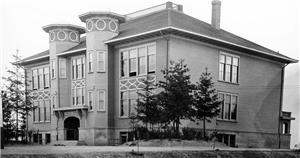This history of John Hay Elementary School is taken from the second edition of Building for Learning: Seattle Public School Histories, which includes histories of every school building used by the district since its formation around 1862. The original essay was written for the 2002 first edition by Nile Thompson and Carolyn J. Marr, and updated for the 2024 edition by HistoryLink contributor Rita Cipalla.
American Statesman
The original John Hay Elementary opened near the corner of Boston and Bigelow streets in 1905 to serve the growing population of east Queen Anne Hill. The school was named after John Hay, an American statesman and author perhaps best known for his role as the private secretary and friend of President Abraham Lincoln.
In 1982, a decision was made to build a new John Hay School on a different site. The new school was built across the street to the south, on the site of Luther Playfield (201 Garfield Street), the former track and field for Queen Anne High School, which had closed in 1981. Though the Queen Anne High School building had been leased and redeveloped as condominiums, the school’s gymnasium and playing field had been retained by the district. The new school opened in 1989 with funds approved in a 1984 levy, and for the first year, John Hay was home to grades K-3. The following year, it expanded to include grades 4 and 5 to align with the district’s new student assignment plan. When the new 51,362 square-foot John Hay Elementary School opened, the original John Hay School building kept the same name, although it was known in the district as the original or “old” Hay. The original Hay buildings were used as an interim site, alternative school site, and administration site until 2010 when they were renamed Queen Anne Elementary School to house a new option elementary school.
From the beginning, John Hay School took an active role in the community and served as a place where residents could enjoy dance performances, plays, adult education classes, and family activities. An urban wildlife habitat was established on school grounds, built by landscape architects and gardeners who volunteered their time. John Hay has a long history of dedication to the arts, and in 1993 it launched a Festival of the Arts. During the festival’s inaugural year, K-5 students studied the works of several local artists. An artist-in-residence originally from Guatemala, Jose Orantes, helped create a new mural; artist Bill Laprade sculpted a stone frog for the school; and world-famous artist Jacob Lawrence, who was then professor emeritus at the University of Washington, attended a student production of a play based on his book, Harriet and the Promised Land.
In 2001, the John Hay Pathway Garden, within the wildlife habitat garden, was created to commemorate four John Hay students who died when Alaska Airlines Flight 261, en route to Seattle from Mexico, crashed off the coast of California on January 31, 2000, killing all 88 people onboard. The garden, on the northeast corner of the playground, includes a walking path and small plaza for gatherings. Many parents and neighborhood residents volunteered their time on the project. A foundation created by former Seattle Sonics basketball guard Gary Payton donated $35,000 toward the total design cost of $80,000 needed to create the memorial garden.
In 2019, John Hay was recognized by the state for high achievement in ELA, math, and student quality and student success, one of seven schools in the district to be recognized in all three areas. Students schoolwide participate in at least one service project per year focused on the needs of others on either a local or global scale.
History
John Hay School
Location: Bigelow & Boston Streets
Building: 8-room wood
Architect: James Stephen
Site: 2.0 acres
1905: Named on July 7; opened in September
1914: Addition (Edgar Blair)
1921: Site expanded to 3.01 acres
1981: Exteriors designated a city landmark
1988: Closed as an elementary school
1989: Opened as a temporary site in January
1992-99: Site of alternative school
John Hay School
Location: 411 Boston Street
Building: 9-room brick
Architect: Floyd A. Naramore
Site: 3.01 acres
1922: Opened
1981: Exterior designated a city landmark
1988: Closed as an elementary school
1989: Opened as a temporary site in January
1992-99: Site of alternative school
2001: Memorial garden created to commemorate four student deaths
2010: Original John Hay School renamed Queen Anne Elementary; opened as an option school
John Hay Elementary School
Location: 201 Garfield Street
Building: 20-room brick facade
Architect: Cardwell-Thomas & Associates
Site: 3.18 acres
1989: Opened in January
John Hay Elementary in 2023
Enrollment: 283
Address: 201 Garfield Street
Nickname: Jaguars
Configuration: K-5
Colors: Red and white

